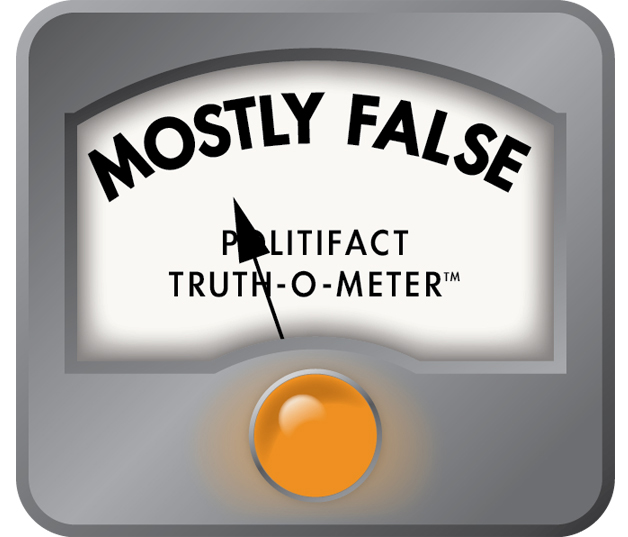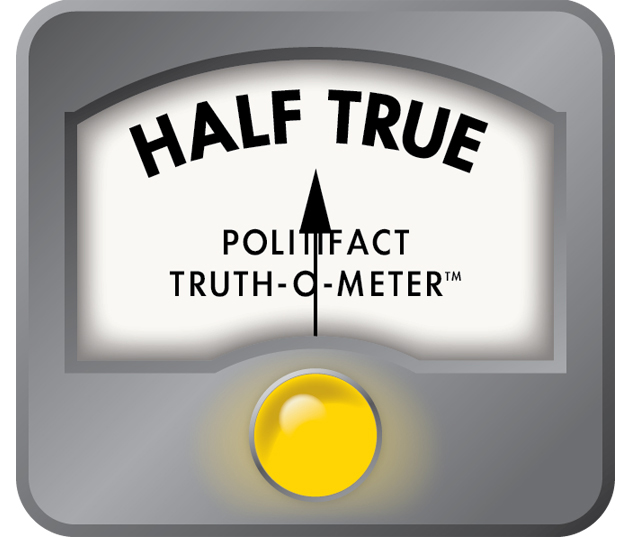Get PolitiFact in your inbox.
This week, Senate Republicans were battered by the same crosswinds that had hit their colleagues in the House in their drive to repeal and replace Obamacare. Facing defections by both uber-conservative and centrist senators, Majority Leader Mitch McConnell, R-Ky., canceled his call for a quick vote.
In announcing the delay, McConnell said he wanted to get more GOP senators to "a comfortable place." The new plan is to follow the House example — hit pause, come back and pass a revised version.
One of the major concerns about the original bill was that it would increase the number of uninsured. A Congressional Budget Office report on the initial bill projected that eight years out, 22 million fewer people would be insured compared with what would happen if the country stuck with the Affordable Care Act.
PolitiFact has fact-checked some of the main talking points deployed this week; here is a brief recap.
House Speaker Paul Ryan argued that some of the uninsured would be uninsured by choice. Citing the CBO, he told Fox News "it's not that people are getting pushed off a plan; it's that people will choose not to buy something they don't like or want."
The Senate bill would ditch the rule that everyone must have health insurance, otherwise known as the individual mandate. Ryan had a point that in the first year of the Senate legislation, the CBO estimated that most of the additional people without coverage would have chosen that route.
But Ryan was specifically asked about the 22 million people who would be without coverage in 2026. The CBO said that year, two-thirds of the newly uninsured, about 15 million, would be that way because of cuts in the Medicaid program, the government-run insurance program for the very poor. On top of that, a portion of the remaining 7 million would want private insurance but would find it too expensive to afford.
We rated Ryan’s claim Mostly False.
The Senate plan cut costs the most by reining in the future growth of Medicaid spending. While the dollars would rise, the increase would be much flatter than under current law, amounting to about $770 billion less in the course of a decade. The plan also trimmed the subsidies that help people of modest means pay for coverage. This gave Republicans plenty of leeway to cut Obamacare taxes and still deliver more than $321 billion in deficit reduction.
Former President Barack Obama posted on Facebook that the bill "hands enormous tax cuts to the rich and to the drug and insurance industries, paid for by cutting health care for everybody else."
Obama’s Affordable Care Act has two taxes aimed directly at the well-to-do, defined as individuals making over $200,000 a year and couples making over $250,000. There are also levies on insurance companies, pharmaceutical companies and medical device makers. The CBO said the total value of eliminating those taxes would be over $540 billion.
Obama went too far in saying that the bill would cut care for "everybody else." Some people do gain under the bill. Young people in particular would find insurance much more affordable. But health care for the poor is cut, while taxes for the wealthy go down.
In large part, his claim held up and we rated it Mostly True.
President Donald Trump has been attacking Obamacare as a means to support Republican efforts. He retweeted a White House message that said, "Obamacare has led to higher costs and fewer health insurance options for millions of Americans."
That might apply if the health care law only addressed the individual insurance market. That’s the slice of the market that about 7 percent of Americans rely on for coverage. The people in it are too young for Medicare, make too much money for Medicaid, and don’t have a job with an employer that provides insurance.
Trump was referring to government regulations in this market when he talked about fewer health options. Every insurance plan is required to cover services that were often optional before, such as maternity and mental health care. Obamacare does deny people the option to buy slimmed down plans.
But Obamacare also includes a ban on denying coverage based on pre-existing conditions, as well as an option for kids to stay on their parents’ plan until they turn 26. And it includes the subsidies for people of modest means who buy insurance through the government-run exchanges in the individual market. It opened up Medicaid to millions more poor people in states that chose to expand the program.
All told, about 20 million people gained coverage under the law. If the only option before was no insurance, being able to get it counts as an added choice.
We rated Trump’s claim that options narrowed as Mostly False.
On the other hand, when Trump went to Milwaukee, Wis., and said "Obamacare premiums have doubled." We rated that Half True.
He was clearly talking about just the individual market, and federal numbers gave him some support. The average premium in Wisconsin in 2013 was $266. In 2017, it was $514 on the government exchange.
Trump left out important details. About 40 percent of people in the individual market don’t buy through the government exchanges. Those people typically are healthier and find a cheaper plan. Factoring in their rates would push the average down.
Also, over 80 percent of the people who buy through the government exchanges get some level of subsidy. The sticker price might rise, but data shows many of them are insulated from that and see a modest rise in their personal bills.
It is also important to note that Republican policies have helped push up premiums. Sen. Marco Rubio, R-Fla., pressed for a law to cut off federal funds to help insurance companies navigate the risks of a new marketplace. More recently, insurers have said the Trump administration's waffling on paying them $7 billion in coverage subsidies has upped their premiums. By one estimate, that policy alone has added 20 percent to the price of premiums as insurance companies hedge their risk in 2018.
The process behind the health care bill, if not the contents, drew rare bipartisan criticism. Senators from both parties objected to McConnell’s decision to write the bill behind closed doors with no hearings.
Sen. Bob Corker, R-Tenn., cautioned this didn’t bode well, as did Sen. Rand Paul, R-Ky.
"Republicans are writing their health care bill under the cover of darkness because they are ashamed of it," said Minority Leader Chuck Schumer, D-NY.
As questions rose over what was in store, Sen. Bernie Sanders, I-Vt., tweeted an image that contrasted the Republican approach to what took place when Democrats crafted the Affordable Care Act.
The Democrats allowed 160 hours of debate; 100 "committee hearings, roundtables, or walkthroughs"; and more than 171 amendments from the opposite party."
Republicans scored zero in every category.
We found that Sanders had a point that the Democratic process in 2009 and 2010 included more active debate than Republicans are allowing in the current debate over the repeal-and-replace legislation.
But he went astray in making his point through an apples-to-oranges comparison. The process isn’t over yet. Under Senate rules, there will be some debate and amendments.
We rated his claim Half True.
Our Sources
See fact-checks in this article.
Congressional Budget Office, Cost estimate: Better Care Reconciliation Act of 2017, June 26, 2017
New York Times, Marco Rubio Quietly Undermines Affordable Care Act, Dec. 9, 2015
Kaiser Family Foundation, Average ACA Marketplace Premiums for Silver Plans Would Need to Increase by 19% to Compensate for Lack of Funding for Cost-Sharing Subsidies, April 6, 2017
New York Times, Secrecy Surrounding Senate Health Bill Raises Alarms in Both Parties, June 15, 2017
New York Times, 13 Men, and No Women, Are Writing New G.O.P. Health Bill in Senate, May 8, 2017
Reuters, Democrats protest Senate Republican healthcare secrecy, June 20, 2017


 PolitiFact Rating:
PolitiFact Rating: 
 PolitiFact Rating:
PolitiFact Rating: 

 PolitiFact Rating:
PolitiFact Rating: 

















































